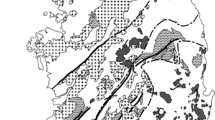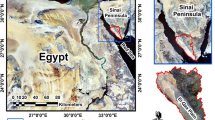Abstract
Every year, the Republic of Korea experiences numerous landslides, resulting in property damage and casualties, especially in weathered granite soil slopes.
This paper compares the predictive capability of two different models, namely shallow landslide stability (SHALSTAB), deterministic model and relative effect (RE) model, a statistical bivariate model for producing shallow landslide susceptibility maps.
Deokjeok-ri Creek was selected for the study. The watershed is mainly covered by granitic soil. For SHALSTAB analysis a digital elevation model was used. The soil strength parameters and physical properties of soil were determined in the laboratory. For the statistical model, the input layers of the landslide conditioning factors were prepared in the first stage. The effects of causative factors on slope stability were mapped on topographical maps of 1:5,000 scale. Mainly geomorphic (slope, aspect, elevation, internal relief, and slope shape), hydrology based (drainage distance, stream power index, topographic wetness index, sediment transport index, drainage density and soil drainage characters), soil type and soil depth distribution and forest type and timber age causative factors and field inventory were used for statistical susceptibility map**. Model performance was assessed using accuracy curve approach. Results show that accuracy is as high as 88.21 % for SHALSTAB, while it is 86.3 % for RE model. Although SHALSTAB has certain drawbacks, as described by previous researchers, this study concluded that in a small watershed and using accurate geotechnical data SHALSTAB can predict the probability of slope failure in Korean mountainous regions.
Access this chapter
Tax calculation will be finalised at checkout
Purchases are for personal use only
Similar content being viewed by others
References
Chung CJ, Fabbri AG (2003) Validation of spatial prediction models for landslide hazard map**. Nat Hazards 30:451–472
Chung YS, Yoon MB, Kim HS (2004) On climate variations and changes observed in South Korea. Clim Chang 66(1–2):151–161
Kim W, Kim K, Chae B, Cho Y (2000) Case study of landslide types in Korea. J Eng Geol 10(2):18–35
Kim J, Jeong S, Park S, Sharma J (2004) Influence of rainfall induced wetting on the stability of slopes in weathered soils. Eng Geol 75(3–4):251–262
Kwon Y, Oh S (2011) Physical and mechanical properties of decomposed granite soils sampled in Cheongju, Korea. Int J Phys Sci 6(24):5777–5794
Lee C, Yoo N (2009) A study on debris flow landslide disasters and restoration at Inje of Kangwon Province, Korea. Korean Soc Hazard Mitig 9(1):99–105
Montgomery DR, Dietrich WE (1994) A physically based model for the topographic control of shallow landsliding. Water Resour Res 30:1153–1171
Moore ID, Wilson JP (1992) Length-slope factors for the revised universal soil loss equation: simplified method of estimation. J Soil Water Conserv 47:423–428
Neelkantan R, Yuvaraj S (2013) Relative effect-based landslide hazard zonation map** in parts of Nilgiris, Tamil Nadu, South India. Arab J Geosci 6:4207–4213. doi:10.1007/s12517-012-0693-4
Rahardjo H, Li XW, Toll DG, Leong EC (2001) The effect of antecedent rainfall on slope stability. Geotech Geol Eng 19(3–4):371–399
Rahardjo H, Lee T, Leong EC, Rezaur RB (2005) Response of a residual soil slope to rainfall. Can Geotech J 42(2):340–351
Soil Survey Staff (1993) “Soil Survey Manual”. Soil Conservation Service. U.S. Department of Agriculture Handbook 18. Archived from the original on 2006-02-14. Retrieved 2006-07-02
van Westen CJ (1997) Statistical landslide hazard analysis ILWIS 2.1 for Windows application guide. ITC, Enschede, pp 73–84
van Westen CJ, Terlien TJ (1996) An approach towards deterministic landslide hazard analysis in GIS. A case study from Manizales (Colombia). Earth Surf Process Landf 21:853–868
Vázquez-Selem L, Zinck AJ (1994) Modeling gully distribution on volcanic terrains in the Huasca area, central Mexico. ITC J 3:238–251
Zinck JA, López J, Metternicht GI, Shrestha DP, Vázquez-Selem L (2001) Map** and modelling mass movements and gullies in mountainous areas using remote sensing and GIS techniques. Int J Appl Earth Obs Geoinf 3(1):43–53
Acknowledgments
This research was supported by the Public Welfare & Safety Research Program through the National Research Foundation of Korea (NRF) funded by the Ministry of Science, ICT & Future Planning (grant No. 2012M3A2A1050977).
Author information
Authors and Affiliations
Corresponding author
Editor information
Editors and Affiliations
Rights and permissions
Copyright information
© 2014 Springer International Publishing Switzerland
About this paper
Cite this paper
Pradhan, A.M.S., Oh, JR., Jung, MS., Kim, YT. (2014).
 Predictive Capability of Deterministic and Statistical Models in Weathered Granite Soil Watershed.
In: Sassa, K., Canuti, P., Yin, Y. (eds) Landslide Science for a Safer Geoenvironment. Springer, Cham. https://doi.org/10.1007/978-3-319-05050-8_78
Predictive Capability of Deterministic and Statistical Models in Weathered Granite Soil Watershed.
In: Sassa, K., Canuti, P., Yin, Y. (eds) Landslide Science for a Safer Geoenvironment. Springer, Cham. https://doi.org/10.1007/978-3-319-05050-8_78
Download citation
DOI: https://doi.org/10.1007/978-3-319-05050-8_78
Published:
Publisher Name: Springer, Cham
Print ISBN: 978-3-319-05049-2
Online ISBN: 978-3-319-05050-8
eBook Packages: Earth and Environmental ScienceEarth and Environmental Science (R0)




